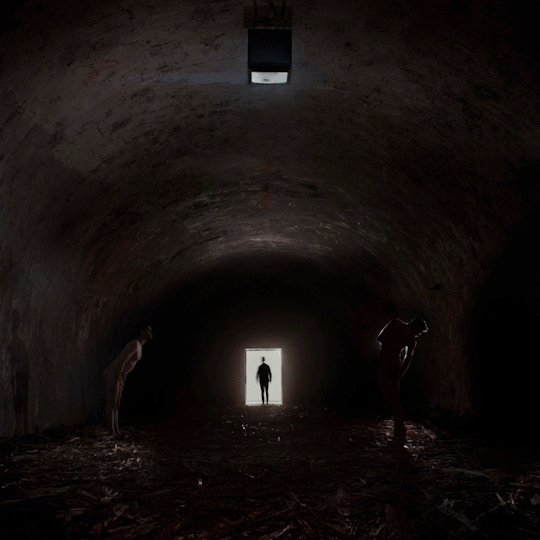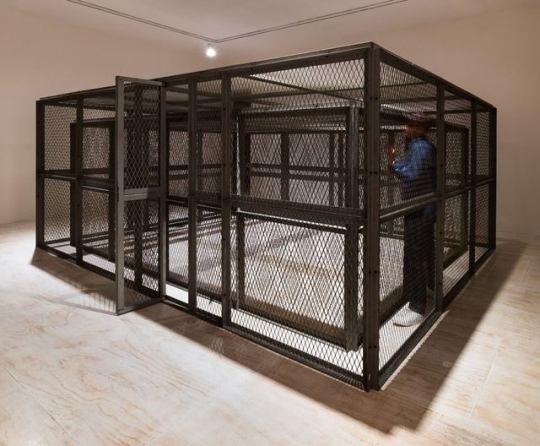We are no longer updating our Tumblr, but please enjoy this page as an archive. Find more exciting content at moma.org/magazine.
Don't wanna be here? Send us removal request.
Quote
We are no longer updating our Tumblr, but please enjoy this page as an archive.
Explore artists and ideas that surprise, challenge, and inspire you on our Magazine, and connect with us on Instagram, Facebook, and Twitter.
577 notes
·
View notes
Photo

Bruce Nauman: Clown Torture
Talking about the often self-humiliating nature of clown routines, #BruceNauman observed “You couldn’t get away with that without makeup. People wouldn’t put up with it, it’s too mean. But in the circus it’s okay, it’s still funny.” In “Clown Torture” (1987), now on view at MoMA PS1, the surveillance-style footage makes the viewer complicit with the distancing perspective of CCTV cameras. Will weallow ourselves to get away with spying on the clown as he desperately tries to fight off boredom while waiting to relieve himself? … [Credit: Bruce Nauman. “Clown Torture.” 1987. Four-channel video installation, two projections, four monitors, color, sound. The Art Institute of Chicago. Watson F. Blair Prize, Wilson L. Mead, and Twentieth-Century Purchase funds; through prior gift of Joseph Winterbotham; gift of Lannan Foundation. © 2019 Bruce Nauman/Artists Rights Society (ARS), New York]
829 notes
·
View notes
Link
Take a closer look at Remedios Varo’s painting “The Juggler” (1956)—a new acquisition to #MoMACollection—with curators Anne Umland and Cara Manes. Varo is one of the most important women artists associated with the Surrealist movement, though she rejected the label. Learn more about her magical, mystical worlds and why this work is sure to shake up the conversation in the galleries.
133 notes
·
View notes
Photo

Brancusi: View of the Artist's Studio
Constantin Brancusi’s studio through the artist’s eyes—a closer look reveals his sculptures “The Kiss” in the background and “Mlle Pogany” in the foreground. Brancusi made fewer than 200 drawings, some of which depicted his studio, a subject that also appeared frequently in his photographs. In both his photographs and drawings, Brancusi shows his works stacked and layered in space. He often moved works from base to base, or placed them directly on the floor of his studio, so that they lived in the world alongside ordinary objects, and among people. Now on view. … [🎨: Constantin Brancusi. “View of the Artist's Studio.” 1918. Gouache and pencil on board. The Joan and Lester Avnet Collection. © Succession Brancusi - All rights reserved (ARS) 2018]
281 notes
·
View notes
Video
youtube
HOW TO SEE: Charles White
Missed our Charles White retrospective? Explore White’s technical prowess, his ability to depict “images of dignity,” and his groundbreaking collaboration with Harry Belafonte, alongside artist Toyin Ojih Odutola, exhibition curator Esther Adler, and MoMA staff, in our latest episode of HOW TO SEE.
280 notes
·
View notes
Link
“Nauman’s principle theme is the body—both his body and ours—as a vessel and a source of information, and he reveals it to be an unstable foundation for understanding our place in the world.” –Taylor Walsh, curatorial assistant, offers a crash course in the work of Bruce Nauman and why his work remains urgent today.
102 notes
·
View notes
Video
tumblr
#ArtSpeaks: Paulina Pobocha on Constantin Brancusi
“I really wanted to treat him as though he were a living artist.” –Paulina Pobocha, associate curator, shares how the curatorial team stayed true to how sculptor Constantin Brancusi wanted his work to be seen. Watch her gallery talk on selected works from our exhibition “Constantin Brancusi Sculpture.”
194 notes
·
View notes
Photo

Constantin Brancusi Sculpture: The Cock
What do you think this work represents? If you guessed a rooster, you view the world a lot like sculptor Constantin Brancusi. Brancusi changed the course of sculpture forever with works that evoked “the essence of things” rather than serving as literal depictions. This simplified form and base, now on view, was carved from a single piece of wild cherry wood. ... [Credit: Constantin Brancusi. “The Cock.” Paris 1924. Cherry. Gift of LeRay W. Berdeau. © Succession Brancusi - All rights reserved (ARS) 2018]
208 notes
·
View notes
Photo

Concrete Utopia: The Monument to the Revolution on Mount Kozara
The Monument to the Revolution on Mount Kozara, designed by Dušan Džamonja from 1970-72, evokes the harrowing experience it was built to commemorate—an intense 1942 battle where Axis troops laid siege to Communist-led resistance units and local civilians. Visitors enter through slits in the tower’s concrete fins to a dark, cramped interior space where light penetrates through an opening at the top, accentuating the tense atmosphere. Explore Towards a Concrete Utopia: mo.ma/concreteutopia … [Photo: Selma Banich (Flickr) [Public domain], via Wikimedia Commons]
#concrete utopia#concreteutopia#moma#museum of modern art#yugoslavia#bosnia and herzegovina#architecture
377 notes
·
View notes
Link
What’s it like working at MoMA? Find out as Slate's “Working” podcast goes inside life at the Museum for its third season. Our photography curator Sarah Meister joins the show for episode two to share all that goes into her job—from pitching exhibits, tracking down and acquiring pieces, to writing those words on the wall that let you know what makes a work special.
107 notes
·
View notes
Video
tumblr
Charles Atlas on Judson Dance Theater
Artist and filmmaker Charles Atlas arrived in New York shortly after the heyday of Judson Dance Theater, and set out to build on and challenge their expanded notion of dance. “When it came to do my own work, I was looking for another way to go... Every generation does something different from the generation before,” he says. Together with Merce Cunningham, Atlas developed “video dance”—works created directly for and incorporating movements of the camera—before going on to have an acclaimed career in his own right.
Atlas reflects on his Judson Dance Theater installation, now on view in our Marron Atrium, and what it was like to revisit Judson’s history in a new interview: mo.ma/atlasonjudson … [Video: Installation view of the exhibition, "Judson Dance Theater: The Work Is Never Done" at MoMA]
92 notes
·
View notes
Video
tumblr
#ArtSpeaks: Nectar Knuckles on Charles White
“That’s a really unique ability...to look at a work of art and feel it seeing you. And in this room, I feel seen.” –Nectar Knuckles, a curatorial fellow in our Department of Drawings & Prints, shares how it feels to enter the #CharlesWhite galleries at the Museum. Watch her full gallery talk on “Spiritual” (1941).
279 notes
·
View notes
Photo

“You cannot be living oblivious of the political time you are in, and artists are the people who can actually say what other people have not yet formed… Dignity has no rest. Dignity doesn't rest.” –Tania Bruguera
On December 3, 2018, Cuban police detained Tania Bruguera and several other Cuban artists for protesting Decree 349. This new law would prohibit independent artists from operating in private and public spaces without the approval of the government. We stand in solidarity with Bruguera and the artists of Cuba in supporting free expression and saying #NoAlDecreto349.
MoMA Chief Curator of Media and Performance Art Stuart Comer and Director of Editorial and Content Strategy Leah Dickerman called the artist days after her release from police custody. Listen as Bruguera shares more about her arrest, how Decree 349 will affect the artistic community in Cuba, and the connection between her activism and her art: mo.ma/decree349
[Artwork details: Installation view of the exhibition "Tania Bruguera: Untitled (Havana, 2000)." February 03, 2018 - March 11, 2018. The Museum of Modern Art. Photo: John Wronn]
199 notes
·
View notes
Photo

Concrete Utopia: Jasenovac Memorial Complex
After World War II, Yugoslavia memorialized its fight against Axis powers, and the millions of wartime casualties suffered, with monuments like this one on the site of a razed concentration camp in Jasenovac, Croatia. The “Stone Flower” serves as a grave marker and an expression of a desire to unify the multiethnic country by demarcating its territory after the war with sites of collective remembrance. Explore Concrete Utopia. … [Bogdan Bogdanovic. “Jasenovac Memorial Complex.” 1959-66. Photo: Valentin Jeck, commissioned by The Museum of Modern Art, 2016]
717 notes
·
View notes
Video
tumblr
Bruce Nauman: Poke in the Eye/Nose/Ear 3/8/94 Edit
Nauman’s own body is a sculptural material that is prodded in slow motion in this early video. Now on view at MoMA PS1 as part of Bruce Nauman: Disappearing Acts, the first comprehensive retrospective of the artist's work in over twenty years, spanning both MoMA and MoMA PS1. Plan a visit for in-depth insight into the diverse facets of his work across fifty years. … [Credit: Bruce Nauman. “Poke in the Eye/Nose/Ear 3/8/94 Edit.” 1994. One video projector, one video player, one video source (color, sound). © 2018 Bruce Nauman/Artists Rights Society (ARS), New York.]
118 notes
·
View notes
Video
tumblr
#ArtSpeaks: Wenxiao Li on Mark Rothko
“This dimensional sensation just roused me out of the depression that I had at that time...and I realized there’s a slight chance that Mark Rothko is going through the same emotional journey as I did.”
–Wenxiao Li, a guest assistant at the Museum, shares how seeing Rothko’s work in the Museum galleries helped her navigate the emotions that come with moving to a new country. Watch her gallery talk on “No. 16 (Red, Brown, and Black)” (1958).
433 notes
·
View notes
Photo

Bruce Nauman: Double Steel Cage Piece
Now at MoMA PS1: Many of Bruce Nauman's architectural works are claustrophobia-inducing spaces that viewers can enter. In "Double Steel Cage Piece" (1974), you traverse a very narrow passage within and around a cage while others watch — a doubly uncomfortable experience. ... [Image: “Double Steel Cage Piece.” 1974. MoMA PS1. © 2018 Bruce Nauman/Artists Rights Society (ARS), New York. Photo: Martin Seck]
616 notes
·
View notes